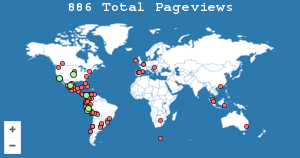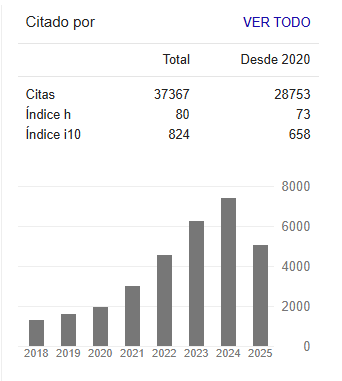Teleworking, a triangle of perceptions: Managers, workers and family members
Resumen
Teleworking requires changes in the previous practices associated with its actors: managers, workers and family members. Not being able to assimilate these changes can affect the satisfaction of each one and generate a set of unfavorable effects in the different roles. In this research, through a survey applied to 321 participants from nine Ecuadorian provinces, assuming an infinite population and ensuring a researcher error of less than 10%, the level of satisfaction of the three roles analyzed was characterized with respect to a group of associated variables. As a result, it can be argued that although telework generates benefits for workers and employers, it requires changes in management methods and provokes different attitudes in the family environment. Regarding managers, although they recognize teleworking as viable, they perceive that their traditional control methods require changes to assume new practices and must be based on higher levels of trust and the development of a results-oriented function. With respect to workers and their families, they recognize that teleworking gives them a set of facilities, although it could affect family relationships and become a source of stress that affects health.
Citas
• Ahmed, F., Kim, S., Nowalk, M.P., King, J., Van Wormer, J., Gaglani, M., Zimmerman, R., Bear, T., Jackson, M., Jackson, L., Martin, E., Cheng, C., Flannery, B., Chung, J., & Uzicanin, A. (2020). Paid leave and access to telework as work attendance determinants during acute respiratory illness, United States, 2017-2018. Emerging Infectious Diseases, 26(1), 26-33. https://doi.org/10.3201/eid2601.190743
• Anderson, A.J., Kaplan, S.A., & Vega, R.P. (2015). The impact of telework on emotional experience: When, and for whom, does telework improve daily affective well-being? European Journal of Work and Organizational Psychology, 24(6), 882-897. https://doi.org/10.1080/1359432x.2014.966086
• Araya-Castillo, L., & Pedreros-Gajardo, M. (2013). Análisis de las teorías de motivación de contenido: una aplicación al mercado laboral de Chile del año 2009. Revista de Ciencias Sociales, 4, (142), 45-61.
• Arso, S.S., Sfenrianto, S., & Wahyudi, M. (2018). Employee performance measurement in teleworking using balanced scorecard. International Journal of Electrical and Computer Engineering, 8(6), 5178-5184. https://doi.org/10.11591/ijece.v8i6.pp.5178-5184
• Arvola, R., & Kristjuhan, Ü. (2015). Workload and health of older academic personnel using telework. Agronomy Research, 13(3), 741-749.
• Arvola, R., Tint, P., Kristjuhan, Ü., & Siirak, V. (2017). Impact of telework on the perceived work environment of older workers. Scientific Annals of Economics and Business, 64(2), 199-214. https://doi.org/10.1515/saeb-2017-0013
• Bae, K.B., & Kim, D. (2016). The impact of decoupling of telework on job satisfaction in U.S. Federal Agencies: Does gender matter? American Review of Public Administration, 46(3), 356-371. https://doi.org/10.1177/0275074016637183
• Barrero, J.M., Bloom, N., & Davis, S.J. (2021). Why working from home will stick. University of Chicago, Becker Friedman Institute for Economics Working Paper, (2020-174). http://dx.doi.org/10.2139/ssrn.3741644
• Belzunegui-Eraso, A., & Erro-Garcés, A. (2020). Teleworking in the context of the Covid-19 crisis. Sustainability (Switzerland), 12, (9). https://doi.org/10.3390/su12093662
• Biron, M., & van Veldhoven, M. (2016). When control becomes a liability rather than an asset: Comparing home and office days among part-time teleworkers. Journal of Organizational Behavior, 37(8), 1317-1337. https://doi.org/10.1002/job.2106
• Castellano, M.I., Caridad, M., Virviescas, J., & Martínez, J. (2017). Telework as a competitive labor strategy in Colombian Pyme. Espacios 38, (31).
• Chávez, Z., Martínez, H., & Durán, D. (2021). Bioética, Reinvención Organizacional y Pandemia Covid-19. Negotium, Revista Científica Electrónica de Negocios, 17(50), 35-48. http://doi.org/10.5281/zenodo.4751671
• De Melo Campos Neves, C. (2020). Teleworking as a differential factor for applying for a job vacancy: A case study with software engineer. 15th Iberian Conference on Information Systems and Technologies (CISTI). Seville, Spain, 24-27 June 2020. https://doi.org/10.23919/CISTI49556.2020.9140833
• Delanoeije, J., Verbruggen, M., & Germeys, L. (2019). Boundary role transitions: A day-to-day approach to explain the effects of home-based telework on work-to-home conflict and home-to-work conflict. Human Relations, 72(12), 1843-1868. https://doi.org/10.1177/0018726718823071
• Elizalde-Hevia, A., Martí-Vilar, M., & Martínez-Salvá, F.A. (2006). Una revisión crítica del debate sobre las necesidades humanas desde el enfoque centrado en la persona. Polis, Revista de la Universidad Bolivariana, 5(15).
• Elldér, E. (2019). Who is eligible for telework? Exploring the fast-growing acceptance of and ability to telework in Sweden, 2005-2006 to 2011-2014. Social Sciences, 8(7). https://doi.org/10.3390/socsci8070200
• Elldér, E. (2020). Telework and daily travel: New evidence from Sweden. Journal of Transport Geography, 86. https://doi.org/10.1016/j.jtrangeo.2020.102777
• Galvez, A., Tirado, F., & Martinez, M.J. (2020). Work-life balance, organizations and social sustainability: Analyzing female telework in Spain. Sustainability (Switzerland) 12(9). https://doi.org/10.3390/su12093567
• García-Madurga, M.A., Grilló-Méndez, A.J., & Morte-Nadal, T. (2021). La adaptación de las empresas a la realidad COVID: una revisión sistemática. Retos, Revista de Ciencias de la Administración y Economía, 11(21), 55-70. https://doi.org/10.17163/ret.n21.2021.04
• García-Rubio, M.P., Silva-Ordoñez, C.A., Salazar-Mera, J.E., & Gavilánez-Paz, F.E. (2021). Modalidad teletrabajo en tiempos de pandemia COVID- 19 en Ecuador. Revista de Ciencias Sociales, 27, 168-180. https://doi.org/10.31876/rcs.v27i.36500
• Gascoigne, C. (2020). Flexible working: lessons from the pandemic. CIPD. https://bit.ly/3tKgsrU
• Gioe, D.V., Hatfield, J.M., & Stout, M. (2020). Can United States intelligence community analysts telework? Intelligence and National Security, 35(6), 885-901. https://doi.org/10.1080/02684527.2020.1767389
• Grange, E.S., Neil, E.J., Stoffel, M., Singh, A.P., Tseng, E., Resco-Summers, K., Fellner, B.J., Lynch, J.B., Mathias, P.C., Mauritz-Miller, K., Sutton, P.R., & Leu, M.G. (2020). Responding to COVID-19: The UW medicine information technology services experience. Applied Clinical Informatics, 11(2), 265-275. https://doi.org/10.1055/s-0040-1709715
• Groen, B.A.C., van Triest, S.P., Coers, M., & Wtenweerde, N. (2018). Managing flexible work arrangements: Teleworking and output controls. European Management Journal, 36(6), 727-735. https://doi.org/10.1016/j.emj.2018.01.007
• Hart, C.W.M. (2012). Los experimentos de Hawthorne. Revista Cubana de Salud Pública, 38(1), 156-167.
• Hazak, A. (2018). Perceived usability of teleworking options in creative knowledge work. 2018 10th International Conference on Knowledge and Smart Technology (KST), Tallinn, 2018. https://doi.org/10.1109/KST.2018.8426117
• Hoornweg, N., Peters, P., & van der Heijden, B. (2016). Finding the optimal mix between telework and office hours to enhance employee productivity: A study into the relationship between telework intensity and individual productivity, with mediation of intrinsic motivation and moderation of office hours. Advanced Series in Management, 16, 1-28.
• Kaplan, S., Engelsted, L., Lei, X., & Lockwood, K. (2018). Unpackaging manager mistrust in allowing telework: comparing and integrating theoretical perspectives. Journal of Business and Psychology, 33(3), 365-382. https://doi.org/10.1007/s10869-017-9498-5
• Lachapelle, U., Tanguay, G.A., & Neumark-Gaudet, L. (2018). Telecommuting and sustainable travel: Reduction of overall travel time, increases in non-motorised travel and congestion relief? Urban Studies, 55(10), 2226-2244. https://doi.org/10.1177/0042098017708985
• Lohman, E. (2015). Running mother ragged: Women and labor in the age of telework Feminist Erasures: Challenging Backlash Culture. Palgrave Macmillan.
• Mayo, M., Gomez-Mejia, L., Firfiray, S., Berrone, P., & Villena, V. (2016). Leader beliefs and CSR for employees: the case of telework provision. Leadership and Organization Development Journal, 37(5), 609-634. https://doi.org/10.1108/lodj-09-2014-0177
• Muto, D., Yokoo, N., & Fujiwara, K. (2019). Reduction of environmental load by telecommuting in Oku-Nikko. IOP Conference Series: Earth and Environmental Science 294, 012008. https://doi.org/10.1088/1755-1315/294/1/012008
• Nilles, J. (1982). Telework may soon make daily long-distance commutes obsolete while enhancing worker productivity and satisfaction. Technology Review, 85(3), 56-62.
• Peters, P., Ligthart, P.E.M., Bardoel, A., & Poutsma, E. (2016). Fit for telework? Cross-cultural variance and task-control explanations in organizations’ formal telework practices. International Journal of Human Resource Management, 27(21), 2582-2603. https://doi.org/10.1080/09585192.2016.1232294
• Pratt, J.H. (1984). Home teleworking: A study of its pioneers. Technological Forecasting and Social Change, 25(1), 1-14. https://doi.org/10.1016/0040-1625(84)90076-3
• Ramírez-Velásquez, J.C., Tapia-Tapia, H.E., Vega-Abad, C.R., & Villagómez, M. (2021). Teletrabajo en Sudamérica: Un desafío jurídico frente al Covid-19. Revista Venezolana de Gerencia, 26(94), 662-677. https://doi.org/10.52080/rvgv26n94.12
• Robbins, S.P., & Judge, T.A. (2009). Comportamiento Organizacional. 13th ed. Pearson Educación.
• Roncal Vattuone, X. (2021). Teletrabajo y Capitalismo de Vigilancia. Telos: Revista de Estudios Interdisciplinarios en Ciencias Sociales, 23(1), 177-192. https://doi.org/10.36390/telos231.14
• Ruiller, C., van der Heijden, B., Chedotel, F., & Dumas, M. (2019). You have got a friend: The value of perceived proximity for teleworking success in dispersed teams. Team Performance Management, 25(1-2), 2-29. https://doi.org/10.1108/tpm-11-2017-0069
• Salgueiro, L., Puel, G., & Fernandez, V. (2017). Location and effects of telework centers in rural areas: the case of Cantal (France). CyberGeo: European Journal of Geography, 827, https://doi.org/10.4000/cybergeo.28510
• Sapién-Aguilar, A.L., Carrera-Ramos, M., Piñón-Howlet, L.C., & Gutiérrez-Diez, M.D. (2016). Competencies of information technology for telework in organizations in México. Publicaciones de la Facultad de Educacion y Humanidades del Campus de Melilla, 46, 31-47.
• Sewell, G., & Taskin, L. (2015). Out of sight, out of mind in a new world of work? Autonomy, Control, and Spatiotemporal Scaling in Telework. Organization Studies, 36(11), 1507-1529. https://doi.org/10.1177/0170840615593587
• Silva-C., A., Montoya, I.A., & Valencia, J.A. (2019). The attitude of managers toward telework, why is it so difficult to adopt it in organizations? Technology in Society, 59. https://doi.org/10.1016/j.techsoc.2019.04.009
• Sukmana, M.I.H., Torkura, K.A., Graupner, H., Chauhan, A., Cheng, F., & Meinel, C. (2020). Supporting internet-based location for location-based access control in enterprise cloud storage solution. Springer Verlag, 926, 1240-1253.
• Takeuchi, K., Yamazaki, Y., & Yoshifuji, K. (2020). Avatar work: Telework for disabled people unable to go outside by using avatar robots “orihime-d” and its verification. HRI ‘20: Companion of the 2020 ACM/IEEE International Conference on Human-Robot Interaction, 53–60. https://doi.org/10.1145/3371382.3380737
• Tintin, R.A., Vela, M., Anzules, V., & Escobar, V. (2015). Smart cities and telecommuting in Ecuador. 2015 Second International Conference on eDemocracy & eGovernment (ICEDEG), 65-72.
• van den Broek, D. (2017). Perforated body work: the case of tele-nursing. Work, Employment and Society, 31(6), 904-920. https://doi.org/10.1177/0950017016674899
• Van Wart, M., Roman, A., Wang, X., & Liu, C. (2019). Operationalizing the definition of e-leadership: identifying the elements of e-leadership. International Review of Administrative Sciences, 85(1), 80-97. https://doi.org/10.1177/0020852316681446
• Vayre, É. (2019). Impacts of telework on the worker and his professional, family and social spheres. Travail Humain, 82(1), 1-39. https://doi.org/10.3917/th.821.0001
• Vrchota, J., Frantíková, Z., & Vlčková, M. (2019). Why some SME’s in the Czech Republic adopt telework and others not? European Countryside, 11(4), 599-615. https://doi.org/10.2478/euco-2019-0033

Esta obra está bajo licencia internacional Creative Commons Reconocimiento-NoComercial-CompartirIgual 4.0.








.png)






























